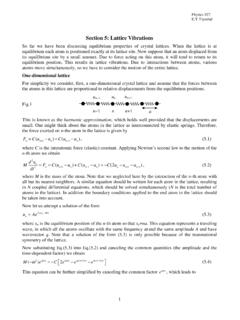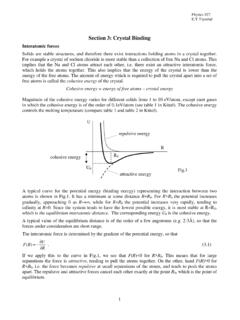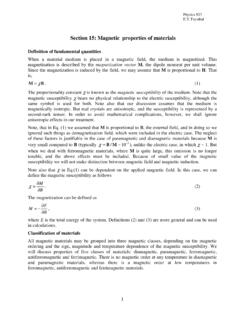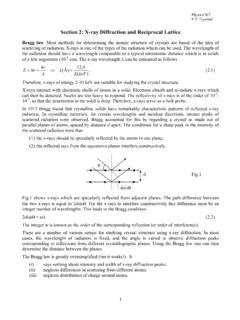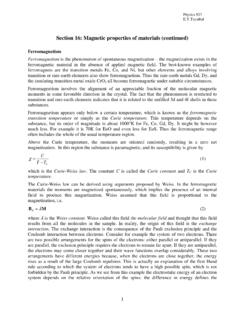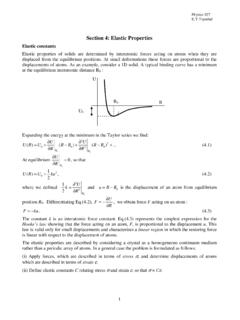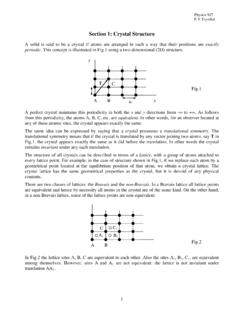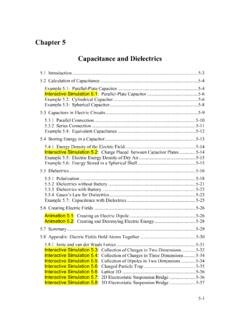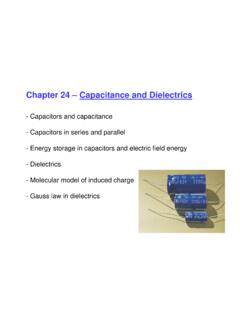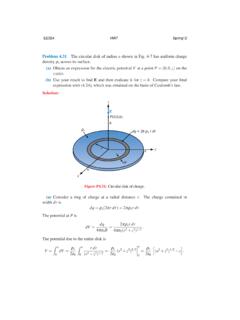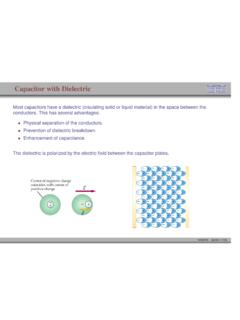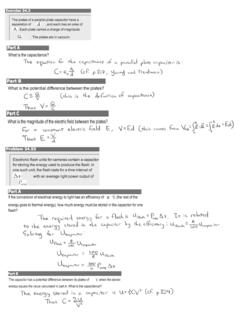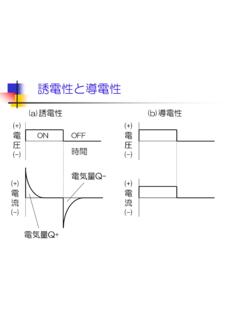Transcription of Section 4: Electrostatics of Dielectrics
1 Section 4: Electrostatics of Dielectrics Dielectrics and Polarizability There are two large classes of substances: conductors and insulators (or Dielectrics ). In contrast to metals where charges are free to move throughout the material, in Dielectrics all the charges are attached to specific atoms and molecules. These charges are known as bound charges. These charges are able, however, to be displaced within an atom or a molecule. Such microscopic displacements are not as dramatic as the rearrangement of charge in a conductor, but their cumulative effects account for the characteristic behavior of dielectric materials. When an external electric field is applied to a dielectric material this material becomes polarized, which means that acquires a dipole moment.
2 This property of Dielectrics is known as polarizability. Basically, polarizability is a consequence of the fact that molecules, which are the building blocks of all substances, are composed of both positive charges (nuclei) and negative charges (electrons). When an electric field acts on a molecule, the positive charges are displaced along the field, while the negative charges are displaced in a direction opposite to that of the field. The effect is therefore to pull the opposite charges apart, , to polarize the molecule. It is convenient to define the polarizability of an atom in terms of the local electric field at the atom: p Eloc . ( ). where p is the dipole moment. For a non-spherical atom will be a tensor. There are different types of polarization processes, depending on the structure of the molecules which constitute the solid.
3 If the molecule has a permanent moment, , a moment is present even in the absence of an electric field, we speak of a dipolar molecule, and a dipolar substance. (a) The water molecule (b) CO2 molecule. An example of a dipolar molecule is the H2O molecule in The dipole moments of the two OH. bonds add vectorially to give a nonvanishing net dipole moment. Some molecules are nondipolar, possessing no permanent moments; a common example is the CO2 molecule in The moments of the two CO bonds cancel each other because of the rectilinear shape of the molecule, resulting in a zero net dipole moment in the absence of electric field. Despite the fact that the individual molecules in a dipolar substance have permanent moments, the net polarization vanishes in the absence of an external field because the molecular moments are randomly oriented, resulting in a complete cancellation of the polarization.
4 When a field is applied to the substance, however, the molecular dipoles tend to align with the field. The reason is that the energy of a dipole p in a local external field Eloc is U p Eloc . It has a minimum when the dipole is parallel to the field. This results in a net non-vanishing dipole moment of the material. This mechanism for polarizability is called dipolar polarizability. 1. If the molecule contains ionic bonds, then the field tends to stretch the lengths of these bonds. This occurs in NaCl, for instance, because the field tends to displace the positive ion Na+ to the right (see ), and the negative ion Cl- to the left, resulting in a stretching in the length of the bond. The effect of this change in length is to produce a net dipole moment in the unit cell where previously there was none.
5 Since the polarization here is due to the relative displacements of oppositely charged ions, we speak of ionic polarizability. Ionic polarization in NaCl. The field displaces Na+ and Cl- ions in opposite directions, changing the bond length. Ionic polarizability exists whenever the substance is either ionic, as in NaCl, or dipolar, as in H2O, because in each of these classes there are ionic bonds present. But in substances in which such bonds are missing - such as Si and Ge - ionic polarizability is absent. The third type of polarizability arises because the individual ions or atoms in a molecule are themselves polarized by the field. In the case of NaCl, each of the Na + and Cl - ions are polarized. Thus the Na+ ion is polarized because the electrons in its various shells are displaced to the left relative to the nucleus, as shown in We are clearly speaking here of electronic polarizability.
6 Fig. Electronic polarization: (a) Unpolarized atom, (b) Atom polarized as a result of the field. Electronic polarizability arises even in the case of a neutral atom, again because of the relative displacement of the orbital electrons. In general, therefore, the total polarizability is given by e i d , (2). which is the sum of the electronic, ionic, and dipolar polarizabilities, respectively. The electronic contribution is present in any type of substance, but the presence of the other two terms depends on the material under consideration. The relative magnitudes of the various contributions in (2) are such that in nondipolar, ionic substances the electronic part is often of the same order as the ionic. In dipolar substances, however, the greatest contribution comes from the dipolar part.
7 This is the case for water, for example. Polarization If electric field is applied to a medium made up of large number of atoms or molecules, the charges bound in each molecule will respond to applied field which will results in the redistribution of charges leading to a polarization of the medium. The electric polarization P(r') is defined as the dipole moment per unit volume. The polarization is a macroscopic quantity because it involves averaging of the dipole moments over a volume which contains many dipoles. We assume that the response of the system to an applied field is linear. This excludes ferroelectricity from discussion, but otherwise is no real restriction provided the field 2. strengths do not become extremely large.
8 As a further simplification we suppose that the medium is isotropic. Then the induced polarization P is parallel to E with a coefficient of proportionality that is independent of direction: P 0 eE . ( ). The constant e is the electric susceptibility of the medium. An important point to note that the electric field which enters eq. ( ) is the a macroscopic electric field which is different from a local electric field entering eq. ( ). The macroscopic field is the average over volume with a size large compared to an atomic size. Now we look at the medium from a macroscopic point of view assuming that the medium contains free charges characterized by the charge density and bound charges characterized by polarization P.
9 We can build up the potential and the field by linear superposition of the contributions from each macroscopically small volume element V at the variable point r'. The free charge contained in volume V is (r') V and the dipole moment of V is P(r') V. If there are no higher macroscopic multipole moment densities, the contribution to the potential (r,r') caused by the configuration of moments in V is given without approximation by 1 (r ) P (r ) r r . (r, r ) V V . ( ). 4 0 r r r r . 3.. provided r is outside V. The first term is the contribution from free charges and the second term is due to a volume distribution of dipoles. We now treat V as (macroscopically) infinitesimal, put it equal to d3r', and integrate over the volume of the dielectric to obtain the potential 1 (r ) P (r ) r r 3.
10 (r ) . 4 0 V r r r r . 3. d r .. ( ). To simplify this equation we use the identity r r 1 1. , ( ). r r . 3. r r r r . where implies differentiation with respect to r'. This allows us to rewrite Eq. ( ) as follows: 1 (r ) 1 . (r ) r r P(r ) r r d r . 3. ( ). 4 0 V . We can take this integral by parts. Taking into account P (r ) 1 1. P (r ) P (r ) , ( ). r r r r r r . an integration by parts transforms the potential into 1 (r ) 1 P (r ) . (r ) r r r r P(r ) r r d r . 3. ( ). 4 0 V . We can now use the divergence theorem to transform the third term in eq.( ) to the integral over surface of the dielectric , which results in 3. 1 d 3r 1 P (r ) n (r ) (r ) P (r ) da . ( ). 4 0 V r r 4 0 S r r . As follows from this expression, the polarization of the medium produces an effective charge which can be interpreted as a macroscopic bound charge or polarization charge.
